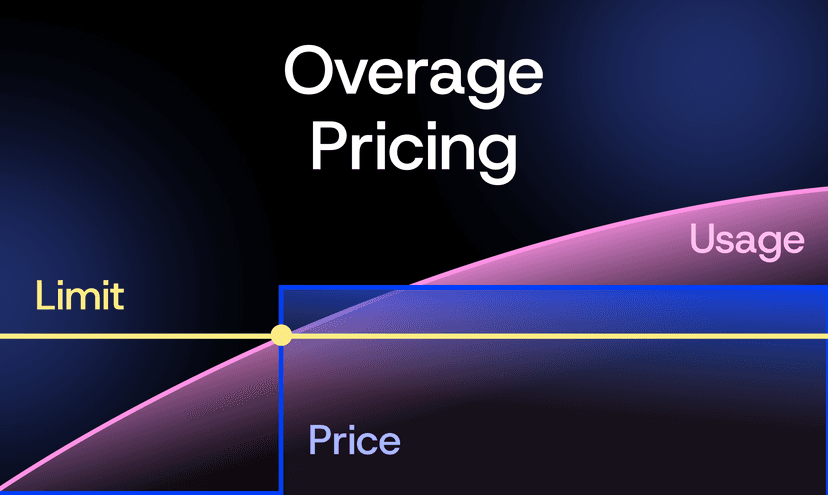

Not sure what overage pricing is? Checkout our Overage Pricing Introduction first.
TL;DR: Overage pricing is popular because it balances predictability with flexibility. But it isn’t the only option. Compared with flat fees, per-seat, or pure pay-as-you-go, it offers a middle ground. Customers know what’s included, vendors capture upside, and both sides trade a little certainty for growth.
Overage pricing is popular because it blends the strengths of predictable subscription plans with the flexibility of usage-based billing. But like any model, it comes with trade-offs:
Benefits
Familiar to customers: Everyone has seen it before (think phone plans), which lowers friction.
Predictable baseline: The included allotment anchors customer budgets and vendor revenue.
Growth-friendly: As usage scales, revenue scales too, without customers having to renegotiate plans.
Easy to implement: Compared to more complex models (like credits or tiers), it’s straightforward.
Drawbacks
Risk of surprise bills: Customers may feel punished if they blow past their allotment unexpectedly.
Limited forecasting: Vendors can count on the baseline, but overage revenue can swing wildly.
Potential friction: If overage rates are too high, customers may feel trapped or pressured to upgrade.
Needs clear communication: Transparency around thresholds and rates is critical to maintain trust.
Suppose your plan includes 10,000 API calls for \$100, with additional calls billed at \$0.01 each. Below are a few examples to demonstrate the total cost of the plan:
Usage This Month | Overage | Total Bill |
9,500 calls | None | \$100 |
12,000 calls | 2,000 × \$0.01 = $20 | \$120 |
25,000 calls | 15,000 × \$0.01 = $150 | \$250 |
Overage pricing sits in the middle ground between fixed plans and pure usage billing. Here’s how it stacks up against other popular models, and when you might choose one over the other:
Model | Why Choose This Instead of Overages | Why Overages Might Be Better |
Flat Fee / Per-Seat | Maximum predictability, costs never change, easy to budget. | Adds flexibility and upside as usage grows, without forcing a plan change. |
Pure Pay-As-You-Go | Perfect alignment with actual usage; no upfront commitment. | Provides a predictable baseline while still scaling with usage. |
Tiered (Graduated/Volume) | Rewards heavy users with cheaper unit costs, feels fair at scale. | Keeps pricing simple and familiar, easier to explain and implement. |
Credit Burndown | Predictable budgeting with flexible usage; customers control commits. | More straightforward and intuitive for most buyers, avoids credit design complexity. |
Overage pricing isn’t always the right fit, but there are clear cases where it shines. Use this quick guide to see if it matches your product and customers:
Use overages if:
Your product has a clear, easy-to-measure usage metric (emails, API calls, events).
Customers expect flexibility but still want a predictable baseline.
Usage can spike unpredictably (common in AI workloads) and you don’t want to block growth.
You want a simple model that’s familiar to buyers and quick to implement.
You want plan design levers: included usage can anchor tiers, promote upgrades, and help customers understand where they fit.
Consider alternatives if:
Your customers demand strict budget predictability (flat fee / per-seat).
You want to reward scale with progressively cheaper unit costs (tiered).
You need to pre-commit revenue or give customers flexibility across many different meters (credit burndown).
Overage pricing is popular because it hits a sweet spot: customers get predictability from their included usage, while vendors capture upside as usage grows. With smart plan design, included allotments not only protect buyers from surprise costs but also guide them toward upgrades as they scale. That balance of trust, flexibility, and growth is why overages remain one of the most enduring pricing models in SaaS and AI.